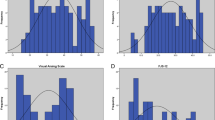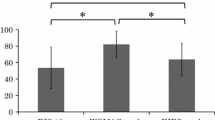Abstract
Purpose
The purpose of this study was to test the hypothesis that the “Forgotten Joint Score” (FJS-12) is a unidimensional interval-level scale. Unidimensionality refers to measuring a single attribute, i.e., the single ability to forget the arthroplasty. If this property is not verified, the interpretation of the score can be confusing. Unidimensionality is an essential prerequisite of construct validity and required if FJS-12 response data are to be validly summated into a single score. Interval-level dimension is an essential prerequisite of the parametric statistics. Rasch analysis was used to test our study hypothesis.
Methods
The FJS-12 questionnaire was validated in 248 unilateral knee arthroplasty patients. Successive analyses were used to select items with good psychometric qualities to constitute the new “FJS”. The external validity was assessed with the KUJALA questionnaire.
Results
Quantity of relevant items was greater than 50%. Of the 12 original items, nine showed disturbed thresholds, indicating that patients were unable to discriminate among the five levels for these items. The data set was reanalyzed using a four-level scale. The new analysis indicated that the internal consistency was good (r = 0.84). Three items did not fit with the model and they were removed. The nine items of the final scale defined a unidimensional and linear measure of the forgotten joint, and showed a continuous progression in their difficulty. The perception of difficulty was group-independent. The correlation coefficient was moderate between FJS and KUJALA score (r = 0.4).
Conclusions
This new and items reduced FJS can be used in clinical practice with good psychometric qualities. It provides a reliable tool to follow up patient’s evolution and document changes related to knee arthroplasty. This valid FJS is needed in evaluating patients’ assessment, one indicator of quality of care.
Level of evidence
III—Therapeutic.


Similar content being viewed by others
References
Andresen EM (2000) Criteria for assessing the tools of disability outcomes research. Arch Phys Med Rehabil 81:S15–S20
Baker PN, van der Meulen JH, Lewsey J et al (2007) The role of pain and function in determining patient satisfaction after total knee replacement. Data from the National Joint Registry for England and Wales. J Bone Joint Surg Br 89:893
Behrend H, Giesinger K, Giesinger JM. Kuster MS (2012) The “forgotten joint” as the ultimate goal in joint arthroplasty: validation of a new patient-reported outcome measure. J Arthroplasty 27(3):430–436
Behrend H, Zdravkovic V, Giesinger JM, 292 Giesinger K (2017) Joint awareness after ACL reconstruction: patient-reported outcomes measured with the Forgotten Joint Score-12. Knee Surg Sports Traumatol Arthrosc 25:1454–1460
Bond TG, Fox CM (2007) Applying the Rasch model: fundamental measurement in the human sciences, 2nd edn. Lawrence Erlbaum Associates, Mahwah
Giesinger JM, Kesterke N, Hamilton DF, Holzner B, Jost B, Giesinger K (2015) Development of item list to assess the forgotten joint concept in shoulder patients. BMC Musculoskelet Disord 16:67
Hamilton DF, Loth FL, Giesinger JM, MacDonald DJ, Patton JT, Simpson AH, Howie CR (2017) Validation of the English language Forgotten Joint Score-12 as an outcome measure for total hip and knee arthroplasty in a British population. J Bone Joint Br 99:218–224
Hiyama Y, Wada O, Nakakita S, Mizuno K (2016) Joint awareness after total knee arthroplasty is affected by pain and quadriceps strength. Orthop Traumatol Surg Res 102(4):435–439
Holland PH, Wainer H (1993) Differential item functioning. Lawrence Erlbaum, Hillsdale.
Kınıklı G, Güney Deniz H, Karahan S, Yüksel E, Kalkan S, Dönder Kara D, Önal S, Sevinç C, Çağlar Ö, Atilla B, Yüksel İ (2017) Validity and reliability of Turkish version of the Forgotten Joint Score-12. J Exerc Ther Rehabil 4:18–25
Kujala UM, Jaakkola LH, Koskinen SK, Taimela S, Hurme M, Nelimarkka O (1993) Scoring of patellofemoral disorders. Arthroscopy 9(2):159–163
Li D, Troelsen A, Ingelsrud L, Husted H, Gromov K (2017) Females, younger patients and patients with high BMI have the highest pre-operative knee awareness measured using the Forgotten Joint Score. Knee Surg Sports Traumatol Arthrosc 16:4446–4445
Linacre JM (1998) Structure in Rasch r 317 esidual: why principal component analysis? Rasch Meas Trans 12(2):636
Nielsen KA, Thomsen MG, Latifi R, Kallemose T, Husted H, Troelsen A (2016) Does post-operative knee awareness differ between knees in bilateral simultaneous total knee arthroplasty? Predictors of high or low knee awareness. Knee Surg Sports Traumatol Arthrosc 24:3352–3358
Pallant JF, Tennant A (2007) An introduction to the Rasch measurement model: an example using the Hospital Anxiety and Depression Scale (HADS). Br J Clin Psychol 46:1–18
Smith EV Jr (2002) Detecting and evaluating the impact of multidimensionality using item fit statistics and principal component analysis of residuals. J Appl Meas 3(2):205–231
Tennant A, Conaghan PG (2007) The Rasch measurement model in rheumatology: what is it and why use it? When should it be applied, and what should one look for in a Rasch paper? Arthritis Rheum 57(8):1358–1362
Thienpont E, Opsomer G, Koninckx A, 341 Houssiau F (2014) Joint awareness in different types of knee arthroplasty evaluated with the Forgotten Joint score. J Arthroplasty 29(1):48–51
Thienpont E, Zorman D (2016) Higher forgotten joint score for fixed-bearing than for mobile-bearing total knee arthroplasty. Knee Surg Sports Traumatol Arthrosc 24:2641–2645
Thienpont E, Vanden Berghe A, Schwab PE, Forthomme JP, Cornu O (2016) Joint awareness in osteoarthritis of the hip and knee evaluated with the ‘Forgotten Joint’ score before and after joint replacement. Knee Surg Sports Traumatol Arthrosc 24:3346–3351
Thomsen MG, Latifi R, Kallemose T, Barfod KW, Husted H, Troelsen A (2016) Good validity and reliability of forgotten joint score in evaluating the outcome of total knee arthroplasty. Acta Orthop 87(3):280–285
Van der velde G, beaton D, Hogg-Johnston S, Hurwitz E, Tennant A (2009) Rasch analysis provides new insights into the measurement properties of the neck disability index. Arthritis Rheum 61(4):544–551
Vandervelde L, Van den Bergh PYK, Goemans N, Thonnard JL (2007) ACTIVLIM: a Rasch-built measure of activity limitations in children and adults with neuromuscular disorders. Neuromuscul Disord 17:459–469
Zhu W, Updyke WF, Lewandowski C (1997) Post-hoc Rasch analysis of optimal categorization of an ordered-response scale. J Outcome Meas 1(4):286–304
Zuiderbaan HA, van der List JP, Khamaisy S, Nawabi DH, Thein R, Ishmael C, Paul S, Pearle AD (2017) Unicompartmental knee arthroplasty versus total knee arthroplasty: which type of artificial joint do patients forget? Knee Surg Sports Traumatol Arthrosc 25:681–686
Funding
This project is not supported by a research grant or funding source.
Author information
Authors and Affiliations
Contributions
All authors worked collectively to develop the protocols and methods described in this paper. DN, ET, and CD were principal investigators responsible for the fieldwork, the statistical analysis, and the writing of the manuscript. All authors contributed to the interpretation of results. All authors read and approved the final manuscript.
Corresponding author
Ethics declarations
Conflict of interest
The authors declare that they have no proprietary, financial, professional, or other personal competing interests of any nature or kind.
Ethics approval
This study was conducted according to the declaration of Helsinki and had ethical approval from the Comité d’Ethique Hospitalo-Facultaire de l’Université Catholique de Louvain (B403201523492).
Rights and permissions
About this article
Cite this article
Niama Natta, D.D., Thienpont, E., Bredin, A. et al. Rasch analysis of the Forgotten Joint Score in patients undergoing knee arthroplasty. Knee Surg Sports Traumatol Arthrosc 27, 1984–1991 (2019). https://doi.org/10.1007/s00167-018-5109-x
Received:
Accepted:
Published:
Issue Date:
DOI: https://doi.org/10.1007/s00167-018-5109-x




